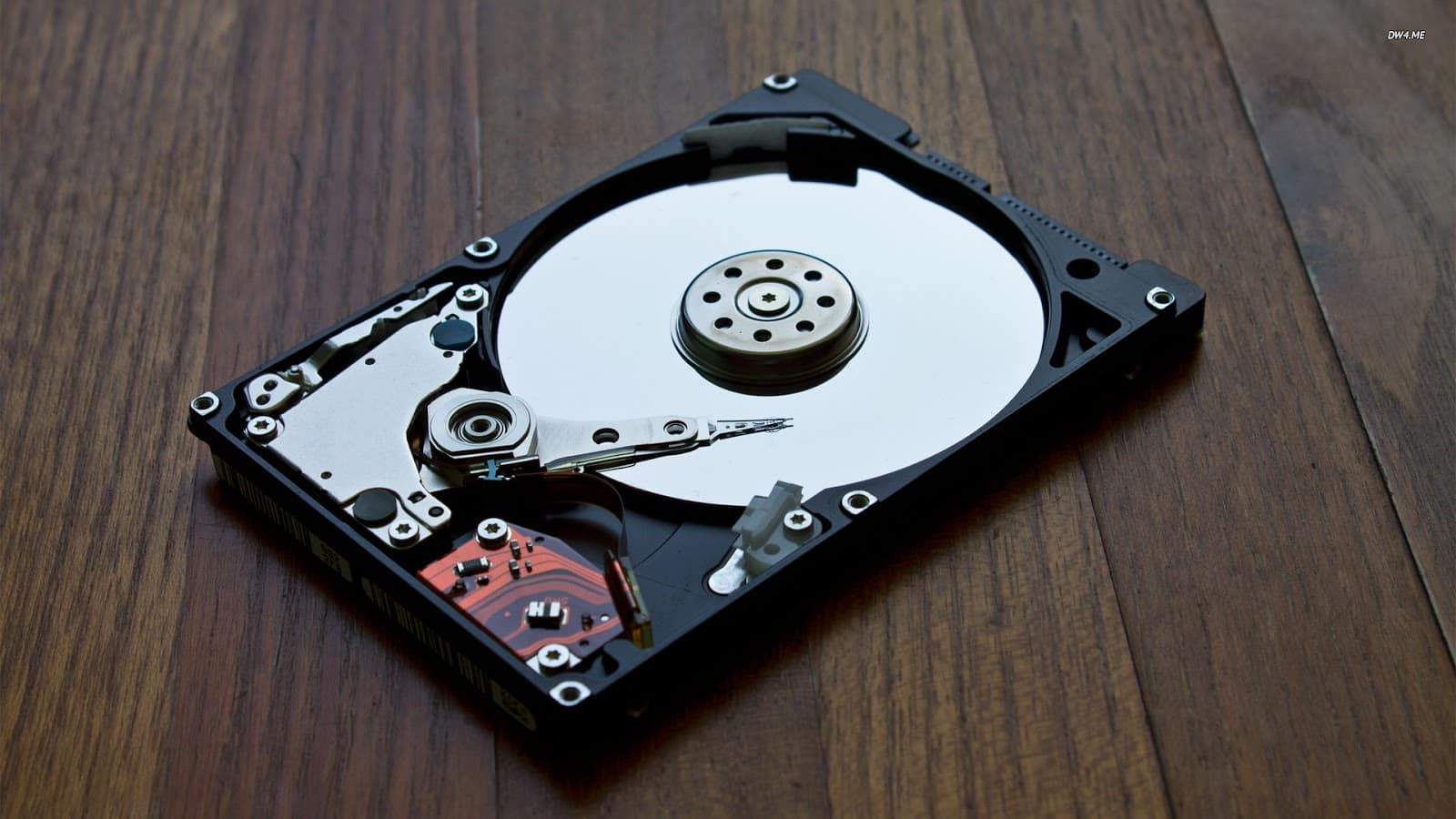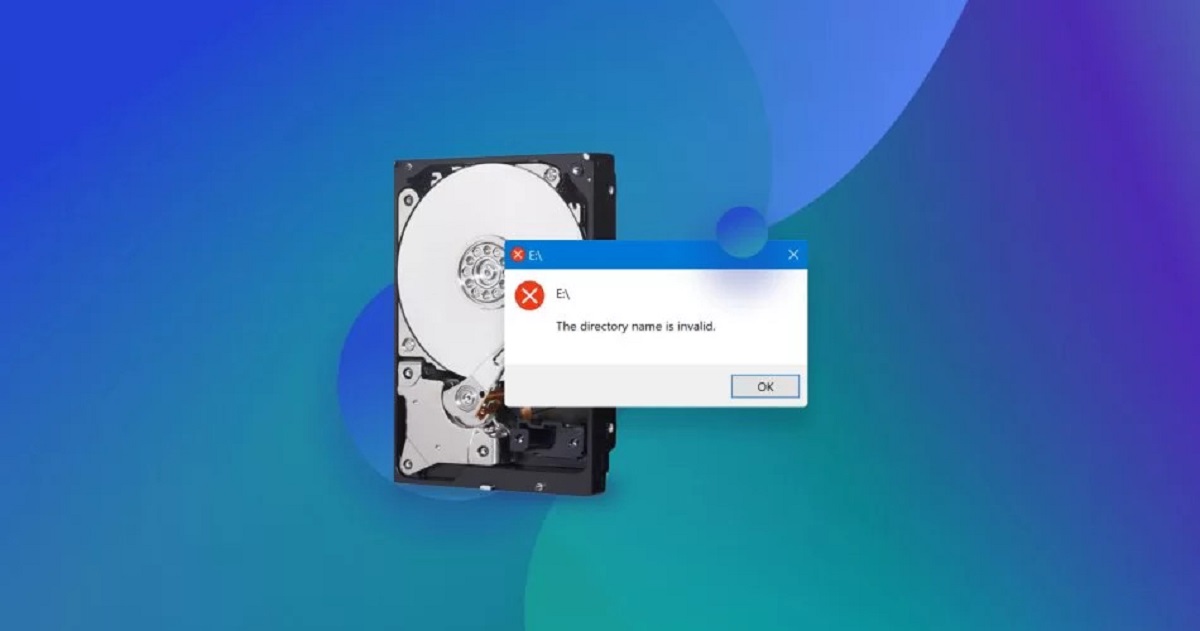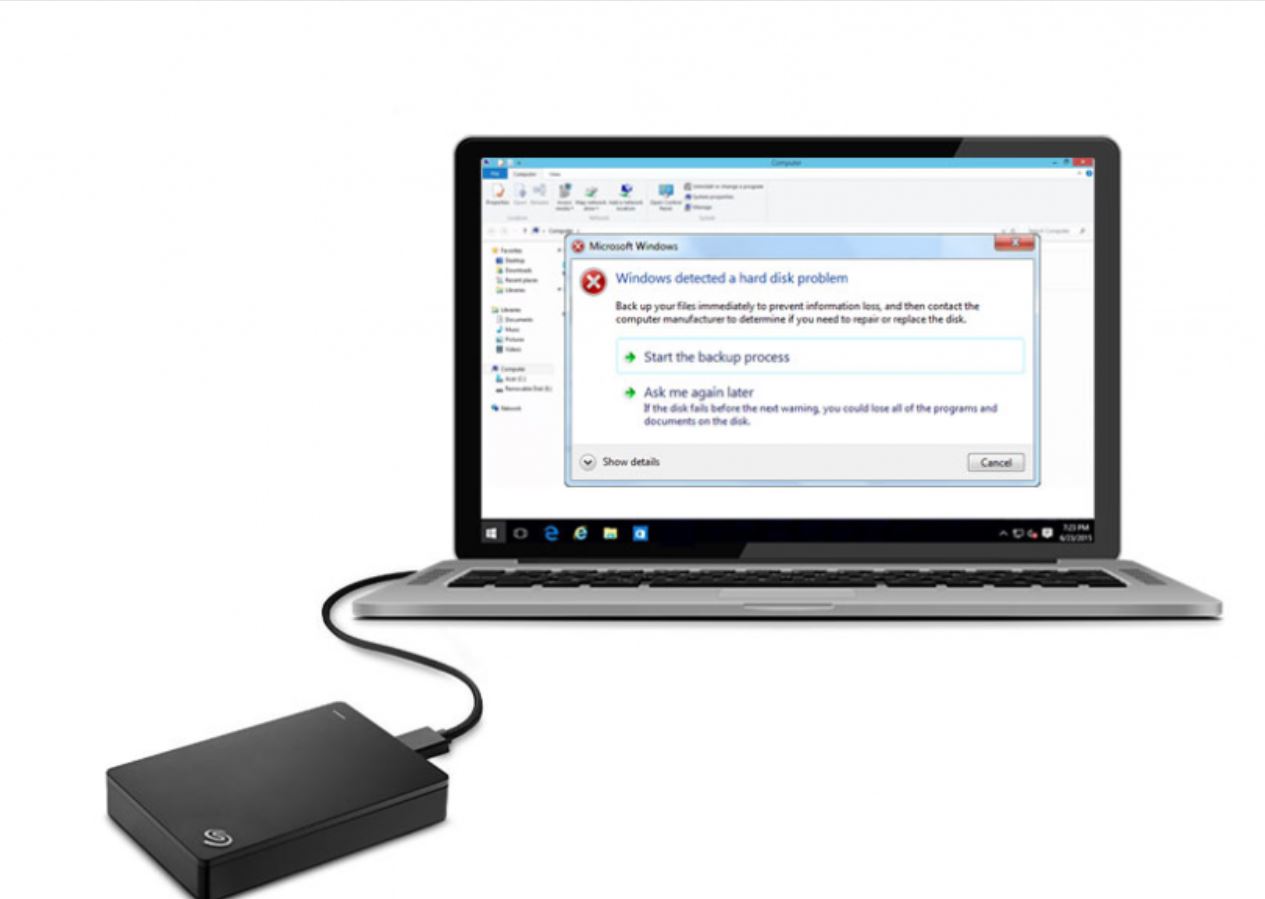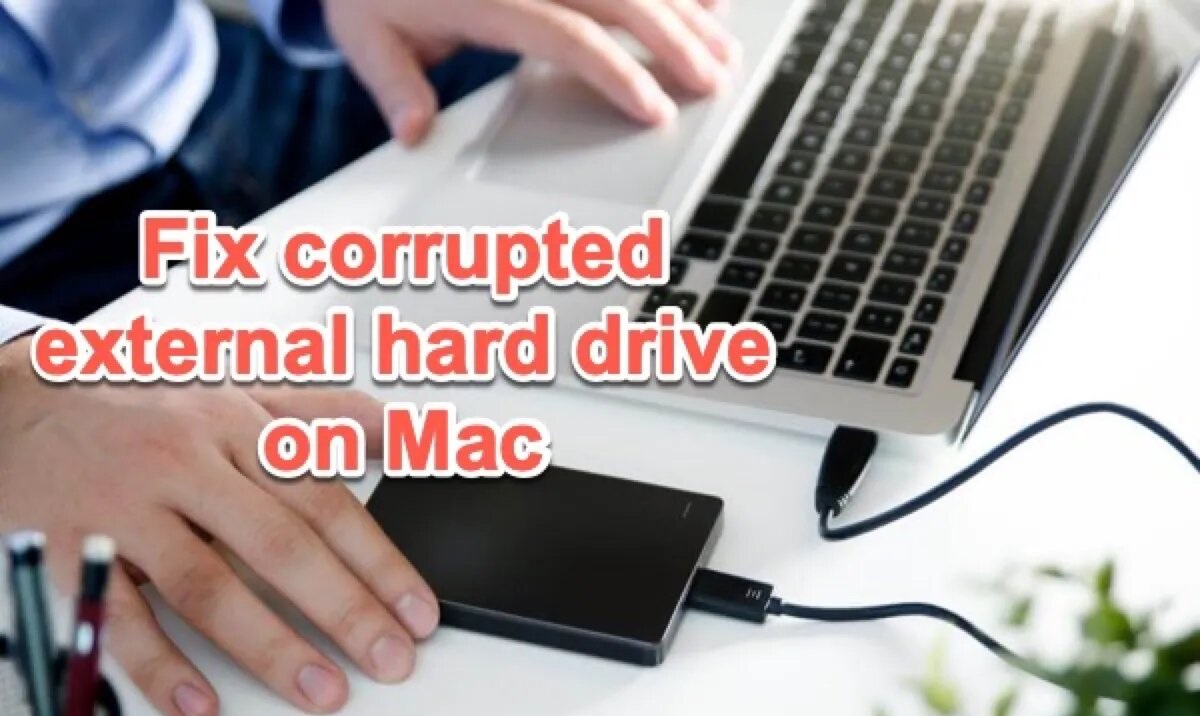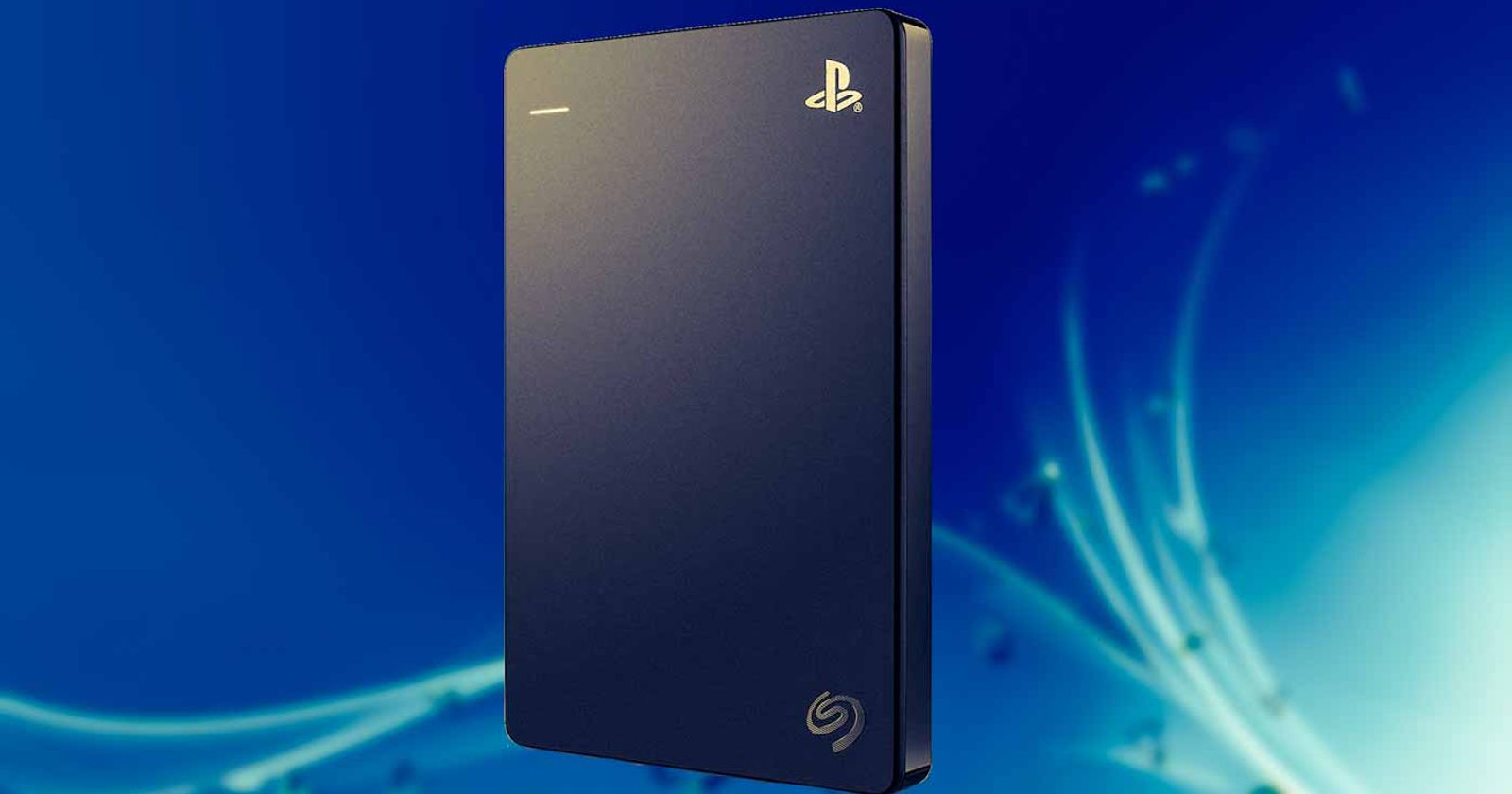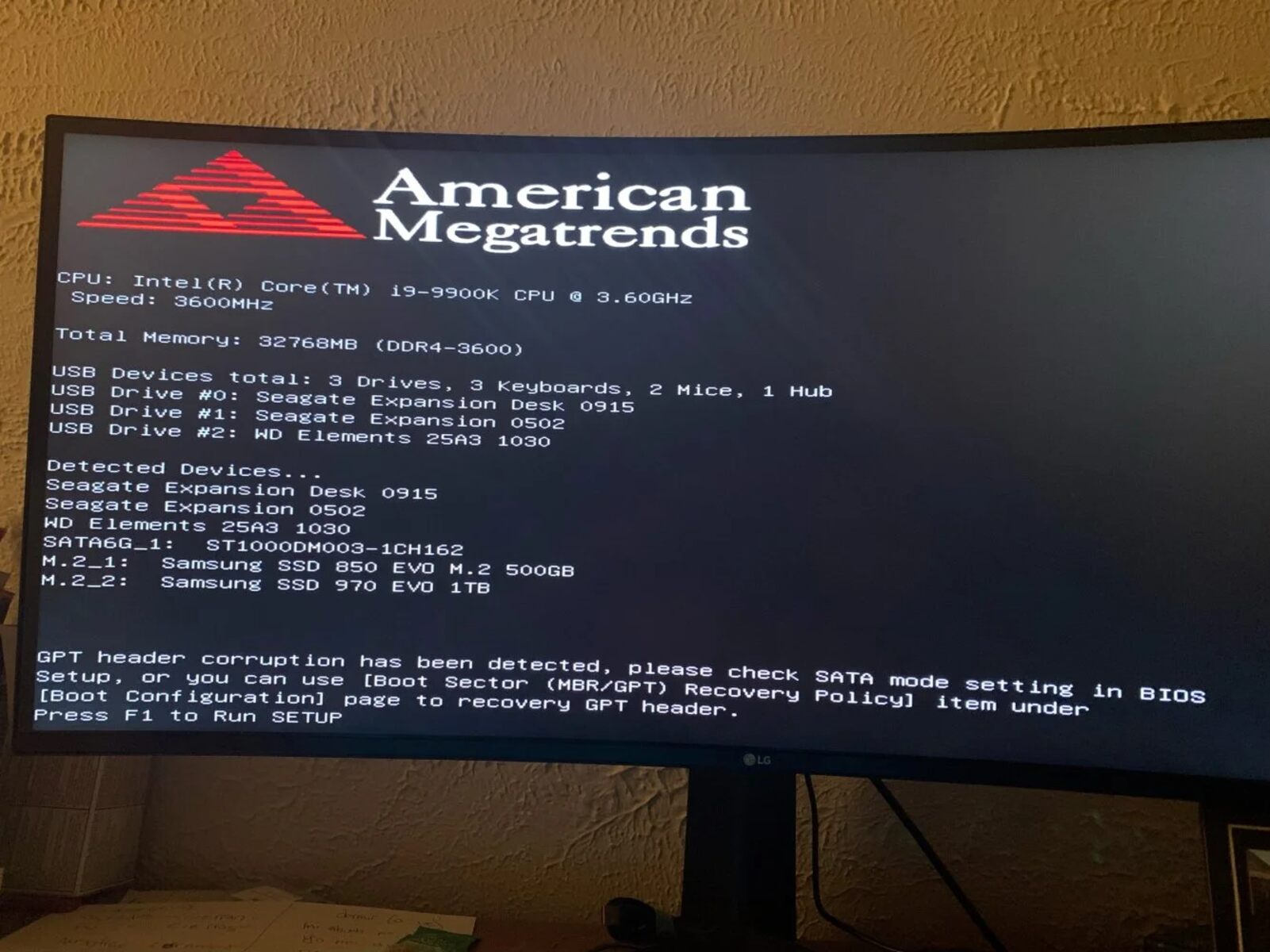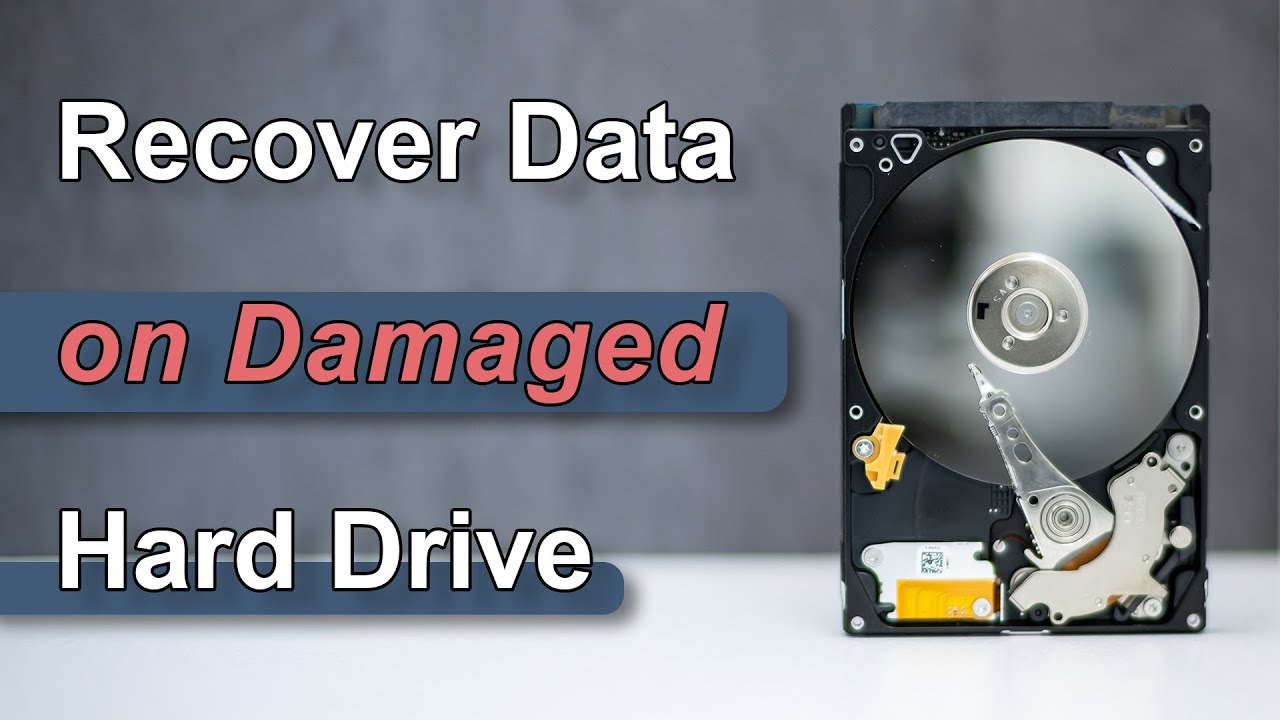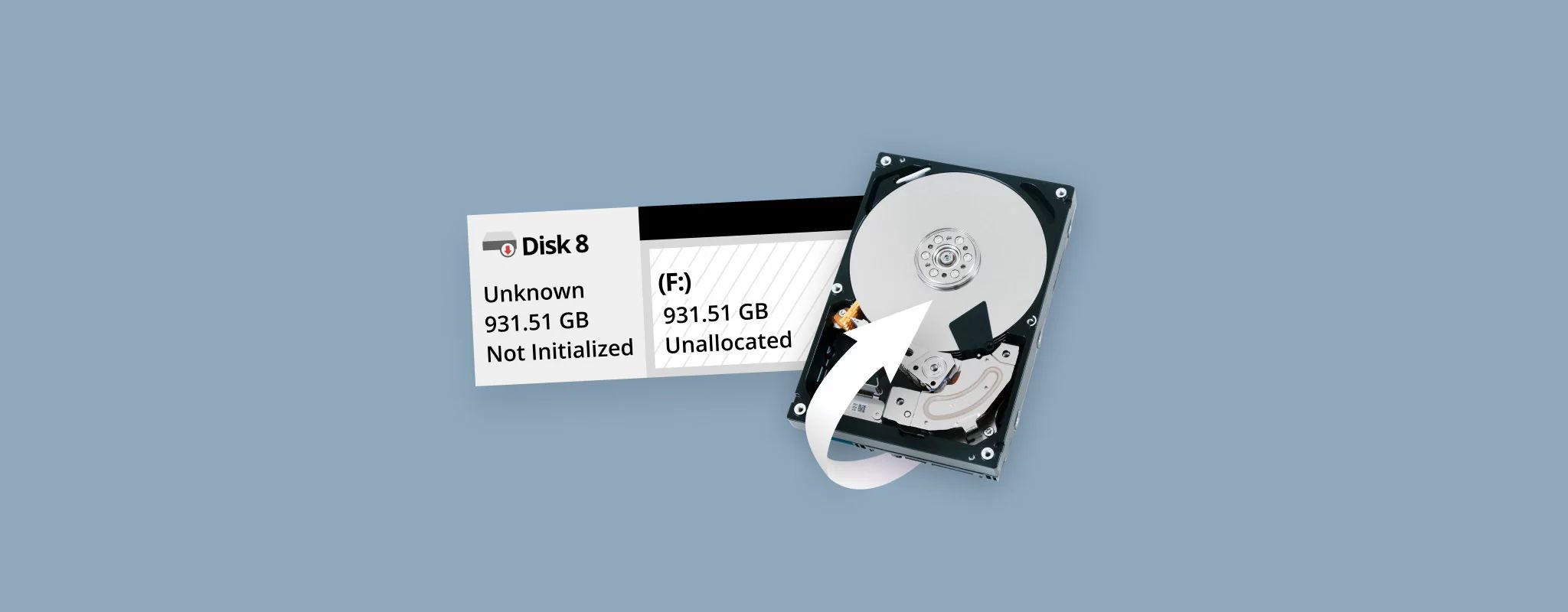Introduction
A hard disk drive (HDD) is an essential component of a computer system, responsible for storing and retrieving data. However, like any other electronic device, it is susceptible to corruption and failures. A corrupted hard disk drive can lead to data loss, system crashes, and a significant disruption in workflow.
Recognizing the signs of a corrupted HDD is crucial to take immediate action and prevent further damage. This article will guide you through the common signs of a corrupted hard disk drive, the causes behind such corruption, and provide a step-by-step guide to fix the issue.
Whether you are using a PC or a Mac, the methods discussed here will help you troubleshoot and restore the functionality of your hard disk drive. It’s important to note that while these steps can help recover data and repair minor corruption issues, serious hardware failures may require professional assistance.
Understanding how to fix a corrupted hard disk drive is valuable knowledge to have, as it can potentially save you time, money, and frustration in the long run. By following the guidelines mentioned in this article, you’ll be equipped with the essential tools to handle HDD corruption issues effectively.
Let’s dive into the common signs that indicate your hard disk drive might be corrupt and explore the various causes behind such corruption.
Common Signs of a Corrupted Hard Disk Drive
As a computer user, it’s important to be aware of the common signs that indicate your hard disk drive may be experiencing corruption. By identifying these signs early on, you can take prompt action and prevent further damage or data loss. Here are some common signs of a corrupted hard disk drive:
- Frequent system crashes: If your computer suddenly freezes, crashes, or encounters the infamous “blue screen of death,” it could be a sign of HDD corruption. When the system cannot access or read data from the hard disk, it can lead to system instability.
- Slow and unresponsive system: If your computer starts to become slow, takes longer to boot up, or frequently freezes during regular operations, the hard disk drive may be struggling to read or write data due to corruption.
- Error messages: Error messages such as “Disk boot failure,” “Invalid system disk,” or “Operating system not found” can indicate HDD corruption. These messages typically occur when the system is unable to access the necessary files to boot or operate properly.
- Clicking or grinding noises: If you hear unusual clicking, grinding, or scratching noises coming from your computer while it is in operation, it may be a sign of physical damage to the hard disk drive. This can lead to data loss and further corruption if not addressed promptly.
- File and folder corruption: In some cases, you may notice that files or folders are becoming inaccessible, showing incorrect file sizes, or producing errors when you try to open them. These issues can occur due to HDD corruption.
If you’re experiencing any of these signs, it’s crucial to address the issue promptly to minimize the risk of data loss or further damage to your hard disk drive. In the next section, we will explore the common causes of HDD corruption to help you better understand how it occurs.
Causes of Hard Disk Drive Corruption
Understanding the causes of hard disk drive (HDD) corruption can help you prevent future issues and take appropriate measures to safeguard your data. Several factors can contribute to hard disk drive corruption, including:
- Physical damage: Physical damage to the hard disk drive, such as dropping the computer or exposing it to extreme temperatures, can lead to corruption. Mechanical failures, such as a malfunctioning read/write head or damaged disk platters, can also cause data loss and corruption.
- Power surges or interruptions: Sudden power surges or interruptions during read or write processes can disrupt the proper functioning of the hard disk drive, resulting in data corruption. It is important to use surge protectors and uninterruptible power supplies (UPS) to minimize the risk of power-related issues.
- Virus or malware infections: Viruses or malware can infiltrate the system and corrupt files on the hard disk drive. These malicious programs can modify, delete, or encrypt data, making it inaccessible and causing system crashes.
- Software or driver conflicts: Conflicts between software applications or incompatible device drivers can lead to conflicts and errors on the hard disk drive. These conflicts can corrupt data or prevent proper read/write operations.
- File system errors: Issues with the file system, such as file system corruption or errors, can cause the hard disk drive to become corrupt. These errors can result from improper system shutdowns, system crashes, or software-related issues.
It’s important to note that these causes of HDD corruption are not exhaustive, and other factors may also contribute to the problem. By being aware of these common causes, you can take preventive measures to minimize the risk of hard disk drive corruption. In the next section, we will provide a step-by-step guide to fix a corrupted hard disk drive.
Step-by-Step Guide to Fix a Corrupted Hard Disk Drive
When you encounter a corrupted hard disk drive (HDD), it’s crucial to take immediate action to prevent further data loss and restore the functionality of your drive. Follow this step-by-step guide to fix a corrupted hard disk drive:
- Assess the Severity of the Issue: Determine the extent of the HDD corruption by evaluating the symptoms and impact on your system. This will help you determine the appropriate course of action.
- Make a Backup of Important Data: Before attempting any repairs, make a backup of critical data on your hard disk drive. This ensures that you have a copy of your files in case any data loss occurs during the fixing process.
- Check for Physical Damage: Inspect the hard disk drive for any physical damage, such as loose connections or visible signs of damage. If physical damage is present, it may require professional assistance for repair.
- Reboot Your Computer: Sometimes, a simple reboot can resolve minor issues with the hard disk drive. Try restarting your computer and check if the HDD corruption persists.
- Use Windows’ Check Disk Utility: For Windows users, you can use the built-in Check Disk utility to scan and repair file system errors on your hard disk drive. Open Command Prompt as an administrator and run the command “chkdsk /f” to start the process.
- Repair Disk Errors with Disk Utility on Mac: Mac users can use the Disk Utility application to repair disk errors on their hard disk drive. Open Disk Utility, select your hard disk drive, and click on the “First Aid” or “Repair Disk” button to initiate the repair process.
- Run Third-Party Data Recovery Software: If the above methods don’t resolve the HDD corruption and you suspect data loss, you can try using third-party data recovery software. These tools can help recover lost or inaccessible data from a corrupted hard disk drive.
- Consult a Professional Data Recovery Service: If the HDD corruption remains unresolved or if you have a severe physical issue with your hard disk drive, it’s recommended to seek professional help from a data recovery service. Professional technicians can assess the damage and perform advanced recovery techniques to retrieve your data.
By following these step-by-step instructions, you can significantly increase the chances of fixing a corrupted hard disk drive. However, prevention is always better than cure. Let’s explore some preventive measures to avoid HDD corruption in the next section.
Assess the Severity of the Issue
When encountering a corrupted hard disk drive (HDD), the first step is to assess the severity of the issue. Understanding the extent of the HDD corruption will help determine the appropriate course of action and prevent further damage or data loss.
Here are some key factors to consider when assessing the severity of the issue:
- Symptoms: Take note of any noticeable symptoms or behaviors exhibited by the hard disk drive. This may include system crashes, slow performance, error messages, or inaccessible files/folders. Documenting these symptoms will provide a clearer picture of the problem.
- Impact on Data: Evaluate the impact of the HDD corruption on your data. Determine whether critical files have been affected or if there is a risk of significant data loss. This assessment will help prioritize the importance of data recovery efforts.
- Frequency and Duration: Consider how frequently the HDD corruption occurs and how long it has been going on. A one-time occurrence may indicate a minor issue, while persistent or recurrent corruption suggests a more significant underlying problem.
- Access to Data: Assess whether you can still access any data stored on the hard disk drive. If the corruption is preventing you from accessing crucial files or if the drive is not recognizable by the system, it may require additional measures to recover the data.
Based on the severity assessment, you can determine the best course of action to fix the corrupted HDD. If the corruption is minor and the impact on data is minimal, simple troubleshooting steps may be sufficient. However, if the issue is severe and data recovery is a top priority, it may be necessary to seek professional help or utilize specialized data recovery tools.
It’s essential to approach the assessment process with patience and caution. Rushing to fix the HDD without a thorough understanding of the severity can lead to further complications or potential data loss.
In the next step, we will discuss the importance of making a backup of important data before attempting any repairs.
Make a Backup of Important Data
Before attempting any repairs on a corrupted hard disk drive (HDD), it is crucial to make a backup of your important data. Creating a backup ensures that you have a copy of your valuable files in case of further data loss or complications during the fixing process.
Here are the steps to make a backup of your important data:
- Identify Critical Data: Determine which files and folders are essential and need to be backed up. This may include documents, photos, videos, and any other irreplaceable data stored on the HDD. Prioritize the most important files first.
- Choose a Backup Method: Select a backup method that suits your needs and preferences. You can choose between physical backups, such as external hard drives or USB flash drives, or cloud-based services that allow remote storage and accessibility.
- Copy Data to Backup Location: Start copying your important data from the corrupted hard disk drive to the backup device or storage location. Be sure to organize your files appropriately and maintain the same folder structure to ease future retrieval.
- Verify Backup Data: Once the backup process is complete, verify the integrity of the backed-up data. Ensure that all files are successfully copied and can be accessed without errors.
- Perform Regular Backups: Establish a habit of regularly backing up your important data to prevent data loss in the event of HDD corruption or other unforeseen circumstances. Set up automated backup schedules if available to streamline the process.
Making a backup of your important data is a proactive measure that safeguards against potential data loss during HDD repairs. It provides peace of mind and allows you to focus on resolving the HDD corruption issue without the fear of permanently losing your valuable files.
In the next step, we will discuss how to check for physical damage on the hard disk drive.
Check for Physical Damage
Checking for physical damage is a crucial step when dealing with a corrupted hard disk drive (HDD). Physical damage can occur due to mishandling, accidents, or other external factors. Identifying and addressing any physical damage is essential before proceeding with further repairs.
Here are the steps to check for physical damage on the hard disk drive:
- Inspect the Exterior: Carefully examine the external casing of the hard disk drive for any visible signs of damage, such as dents, scratches, or cracks. Pay close attention to the connectors and ports as well.
- Listen for Unusual Noises: Power on the computer and listen for any unusual noises coming from the HDD. Clicking, grinding, or repetitive scratching sounds can indicate mechanical issues and physical damage.
- Check Connections: Ensure that the connections between the hard disk drive and the computer are secure and properly connected. Loose or faulty connections can cause data corruption or prevent the drive from functioning correctly.
- Monitor Temperature: Overheating can cause physical damage to the hard disk drive. Check the temperature of the drive using monitoring software or BIOS settings. If the temperature exceeds normal limits, it may indicate a cooling system issue.
If any physical damage is detected, it is advisable to seek professional assistance or consult a trusted technician. DIY attempts to repair physical damage may lead to further complications or complete data loss.
On the other hand, if there is no visible physical damage to the HDD, it is still recommended to proceed with caution. Remember that not all physical damage is externally visible, and the internal components may have suffered harm.
By thoroughly checking for physical damage, you can ensure that the next steps for repairing the corrupted HDD are appropriate and safe. In the next step, we will discuss how to reboot your computer as an initial troubleshooting step.
Reboot Your Computer
When dealing with a corrupted hard disk drive (HDD), a simple but often effective troubleshooting step is to reboot your computer. Restarting the system can help resolve minor issues and provide a fresh start for the HDD to function properly.
Here’s how to reboot your computer:
- Save and Close Programs: Before rebooting, save any unsaved work and close all open programs. This ensures that your data is not lost during the process.
- Click on Restart: On a Windows computer, click on the Start menu and select Restart from the power options. On a Mac, click on the Apple menu and choose Restart.
- Wait for the Restart: Allow your computer to shut down and restart. Depending on the system and any pending updates, the reboot process may take a few minutes.
- Check HDD Functionality: Once the computer has rebooted, check for any improvements in HDD functionality. Test if the HDD corruption symptoms have been resolved or if the drive is functioning better.
Rebooting the computer can often resolve temporary issues with the HDD, such as software conflicts or minor errors. It clears the system’s memory and reloads the operating system, giving the HDD a fresh start.
If rebooting your computer does not resolve the HDD corruption issue, move on to the next steps outlined in this guide. It’s important to note that if the HDD corruption persists or worsens, further troubleshooting or data recovery measures may be required.
In the next step, we will discuss how to use Windows’ Check Disk utility to scan and repair file system errors on the hard disk drive.
Use Windows’ Check Disk Utility
If you’re using a Windows computer and encountering a corrupted hard disk drive (HDD), one effective tool at your disposal is the Check Disk utility. This built-in Windows feature scans and repairs file system errors on the hard disk drive, helping to resolve corruption issues.
Here is how to use Windows’ Check Disk utility:
- Open Command Prompt as Administrator: Press the Windows key, type “cmd,” and right-click on the Command Prompt result. Select “Run as administrator” to open Command Prompt with administrative privileges.
- Run the Check Disk Command: In the Command Prompt window, type the command “chkdsk /f” followed by the drive letter of the corrupted hard disk drive. For example, if the HDD is assigned the letter “C,” the command would be “chkdsk /f C:”. Press Enter to execute the command.
- Confirm to Run at Next Restart: Depending on the current status of the hard disk drive, you may receive a message stating that the drive is in use and cannot be checked immediately. In such cases, type “Y” to schedule the Check Disk to run at the next system restart.
- Restart Your Computer: Close all open applications and restart your computer. The Check Disk utility will automatically run during the reboot process.
- Monitor the Check Disk Process: During the restart, you will see the Check Disk utility in action, scanning the hard disk drive and repairing any identified file system errors. It may take some time to complete, depending on the size of the drive and the amount of data stored on it.
- Review the Check Disk Report: After the Check Disk utility completes its scan and repairs, your system will boot normally. You can review the Check Disk report, which provides details on the scan’s results, including any repairs made.
The Check Disk utility is a powerful tool that can fix file system errors and resolve minor HDD corruption issues. However, it’s important to note that this method may not be effective for severe corruption or physical damage to the hard disk drive.
If the Check Disk utility does not resolve the HDD corruption or if data loss occurs, it may be necessary to explore alternative solutions such as data recovery software or seek professional assistance.
In the next step, we will discuss how to repair disk errors with Disk Utility on Mac systems.
Repair Disk Errors with Disk Utility on Mac
If you’re using a Mac and experiencing a corrupted hard disk drive (HDD), you can utilize the Disk Utility application to repair disk errors. Disk Utility is a built-in tool that allows you to verify and fix file system errors on the Mac’s hard disk drive.
Here is how to repair disk errors with Disk Utility on Mac:
- Open Disk Utility: Go to the Applications folder, then open the Utilities folder, and launch Disk Utility.
- Select the Hard Disk Drive: In the Disk Utility window, select the corrupted hard disk drive from the list of available drives on the left-hand side. It will often be labeled with the manufacturer’s name and the size of the drive.
- Click on the “First Aid” or “Repair Disk” Button: With the corrupted HDD selected, click on the “First Aid” or “Repair Disk” button in the Disk Utility toolbar or the sidebar.
- Start the Repair Process: Disk Utility will start scanning the hard disk drive for errors and repair any issues it finds. This process may take some time depending on the size and extent of the corruption.
- Review the Repair Results: Once the repair process is complete, Disk Utility will display a report detailing the actions taken and any issues that were resolved. Review this report to ensure that the repairs were successful.
- Exit Disk Utility: After verifying the repair results, close the Disk Utility application. You can now test the functionality of the repaired HDD and monitor it for any further signs of corruption.
The Disk Utility application is a powerful tool that can help identify and repair disk errors on a Mac’s hard disk drive. However, similar to the Windows Check Disk utility, it may not be effective for severe corruption or physical damage.
If repairing disk errors with Disk Utility does not resolve the issue or if data loss occurs, consider using data recovery software or seek professional help to recover your data.
In the next step, we will explore using third-party data recovery software as an option to recover data from a corrupted hard disk drive.
Run Third-Party Data Recovery Software
If you have a corrupted hard disk drive (HDD) and need to recover lost or inaccessible data, running third-party data recovery software can be an effective solution. These specialized software applications are designed to scan the corrupted HDD and retrieve as much data as possible.
Here’s how to run third-party data recovery software:
- Research and Choose Reliable Software: Conduct thorough research to find reputable and reliable data recovery software that is compatible with your operating system. Read reviews, compare features, and select the software that best suits your needs.
- Install and Launch the Software: Download and install the chosen data recovery software on a separate computer or storage device to prevent overwriting any data on the corrupted HDD. Launch the software when ready.
- Select the Corrupted Hard Disk Drive: Connect the corrupted HDD to the computer where the data recovery software is installed. In the software interface, select the corrupted HDD as the target for the recovery process.
- Initiate the Scan: Start the scanning process using the data recovery software. Depending on the size and condition of the corrupted HDD, the scanning process may take some time. Be patient and allow the software to scan thoroughly.
- Preview and Recover Found Data: Once the scanning process is complete, the software will display a list of recoverable files. Review the files, preview them if possible, and select the data you want to recover. Choose a safe location to save the recovered files.
- Save and Secure Recovered Data: After selecting the files to recover, follow the prompts to save the recovered data to the designated location. Avoid saving the recovered files back onto the corrupted HDD to prevent further data loss.
- Ensure Data Integrity: Verify the integrity of the recovered data by opening and accessing the files. Check if the recovered files are complete and readable. Make multiple backups of the recovered data to ensure their safety.
Using third-party data recovery software can be a successful method to recover data from a corrupted HDD. However, it’s important to note that the effectiveness of the software depends on the extent of the corruption and the condition of the hard disk drive.
If the data recovery software does not retrieve all of the desired data or encounters difficulties, consult a professional data recovery service for further assistance.
In the next step, we will discuss the option of consulting a professional data recovery service for more severe HDD corruption cases.
Consult a Professional Data Recovery Service
If you are unable to recover the data from your corrupted hard disk drive (HDD) using software or if the corruption is severe, it may be time to consult a professional data recovery service. These specialized services have the expertise and tools to handle more complex HDD corruption cases and maximize the chances of data recovery.
Here’s what to consider when consulting a professional data recovery service:
- Research Reputable Service Providers: Conduct thorough research to find reputable data recovery service providers with a proven track record of successful recoveries. Look for companies with experienced technicians and positive customer reviews.
- Inquire About Expertise and Specializations: Confirm that the data recovery service has experience with HDD recoveries and expertise in handling the specific type of corruption you are experiencing. Some services specialize in specific types of recoveries, such as physical damage or logical errors.
- Assess Security and Confidentiality Measures: Ensure that the data recovery service has robust security measures in place to protect the privacy and confidentiality of your recovered data. Inquire about their policies regarding data privacy and protection.
- Get a Quote and Evaluation: Contact the data recovery service to discuss your HDD corruption issue and request a quote for their services. They may evaluate the extent of the damage and provide an estimated cost and timeframe for the recovery process.
- Decide on Data Recovery Options: Based on the evaluation and quote, decide whether to proceed with the data recovery service. Consider factors such as the importance of the data, the cost of the service, and the potential for successful recovery.
- Submit the Corrupted HDD: If you decide to proceed with the data recovery service, follow their instructions for securely packaging and shipping the corrupted HDD to their facility. Ensure that the package is properly protected to prevent any further damage during transit.
- Review Recovered Data and Pay for Services: After the data recovery service completes the recovery process, they will provide you with access to the recovered data. Review the data to ensure its completeness and integrity before paying for the services rendered.
Consulting a professional data recovery service is an excellent option for severe HDD corruption cases or situations where valuable data is at stake. These experts have the tools, knowledge, and infrastructure to perform advanced recovery techniques and maximize the chances of successful data retrieval.
Keep in mind that professional data recovery services can be costly, so it’s important to weigh the value of the data against the potential cost of recovery.
In the next section, we will discuss preventive measures to avoid HDD corruption and mitigate the risk of data loss.
Preventive Measures to Avoid HDD Corruption
While it is not always possible to completely prevent HDD corruption, there are several preventive measures you can take to minimize the risk and mitigate the potential for data loss. By following these measures, you can help maintain the health and functionality of your hard disk drive (HDD).
Here are some preventive measures to avoid HDD corruption:
- Regularly Back Up Your Data: Make it a habit to regularly back up your important data to an external hard drive, cloud storage, or another secure location. This will protect your data in case of HDD corruption or other unforeseen circumstances.
- Use Surge Protectors and UPS: Power surges and interruptions can damage the HDD. Invest in surge protectors to prevent sudden voltage spikes and uninterruptible power supplies (UPS) to maintain power during outages, giving you time to save your work and safely shut down the system.
- Avoid Physical Damage: Handle your computer and HDD with care to avoid physical damage. Avoid dropping the device, jarring it, or subjecting it to extreme temperatures. Additionally, be cautious when connecting or disconnecting cables to prevent damaging the HDD interfaces.
- Keep Your System Cool: Excessive heat can damage the internal components of the HDD. Ensure proper cooling by keeping your computer clean and well-ventilated. Consider using cooling pads or fans to maintain optimal operating temperatures.
- Use Reliable Software: Install and regularly update reputable antivirus software to protect your system from malware and viruses. Additionally, ensure that your operating system and applications are up to date to avoid software conflicts that can lead to HDD corruption.
- Avoid Abrupt Shutdowns: Always shut down your computer using the proper procedure rather than abruptly disconnecting the power. Improper shutdowns can lead to file system errors and potential data corruption on the HDD.
- Monitor Disk Health: Use disk monitoring tools or utilities to regularly check the health and performance of your hard disk drive. These tools can alert you to potential issues, allowing you to take action before any major problems occur.
- Handle Software Installations with Caution: When installing new software or making system changes, do so with caution. Always follow proper installation procedures, avoid installing untrusted or pirated software, and be cautious with system tweaks that can impact the stability of the HDD.
By implementing these preventive measures, you can significantly reduce the risk of HDD corruption and data loss. However, it’s important to remember that no precautionary measure is foolproof, and occasionally, HDD corruption can still occur unexpectedly.
In the next section, we will conclude our discussion on fixing and preventing HDD corruption, summarizing the key points mentioned throughout the article.
Conclusion
Dealing with a corrupted hard disk drive (HDD) can be a challenging and stressful experience. However, by following the step-by-step guide provided in this article, you can increase the chances of fixing the issue and recovering your valuable data.
We began by discussing the common signs of a corrupted HDD, which include frequent system crashes, slow performance, error messages, unusual noises, and file/folder corruption. Understanding these signs can help you identify HDD corruption early on.
We then explored the causes of HDD corruption, such as physical damage, power surges, malware infections, software conflicts, and file system errors. Becoming aware of these causes enables you to take preventive measures and minimize the risk of HDD corruption.
The step-by-step guide outlined methods for assessing the severity of the HDD issue, making a backup of important data, checking for physical damage, rebooting the computer, using Windows’ Check Disk utility, and repairing disk errors with Disk Utility on Mac.
If these methods did not resolve the issue, we discussed running third-party data recovery software to retrieve lost or inaccessible data. In more severe cases, consulting a professional data recovery service can be the best course of action.
Finally, we highlighted preventive measures to avoid HDD corruption, such as regular backups, using surge protectors and UPS, avoiding physical damage, maintaining proper cooling, using reliable software, preventing abrupt shutdowns, monitoring disk health, and handling software installations with caution.
Remember, while these guidelines can help fix HDD corruption and safeguard your data, severe physical damage may require professional assistance. Prioritizing data backups and taking preventive measures are key to minimizing the impact of HDD corruption.
By being proactive and following the steps outlined in this article, you can increase your chances of successfully addressing HDD corruption issues and maintaining the functionality and longevity of your hard disk drive.







